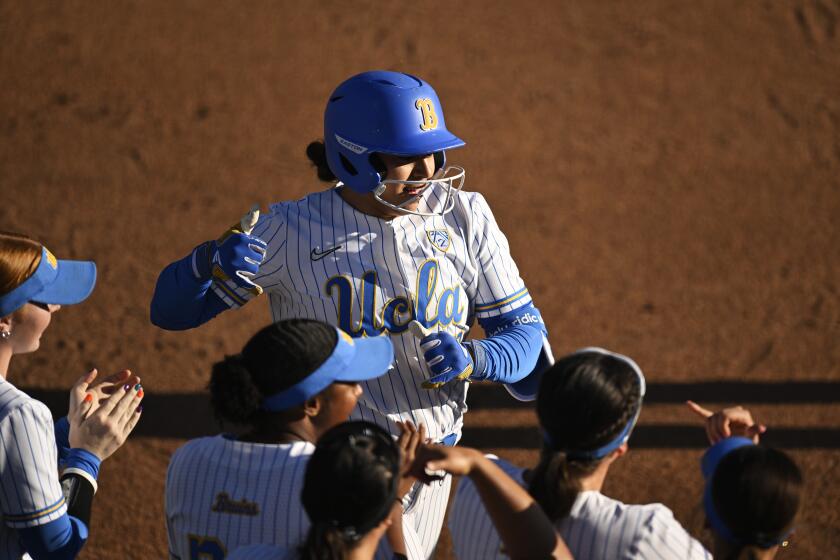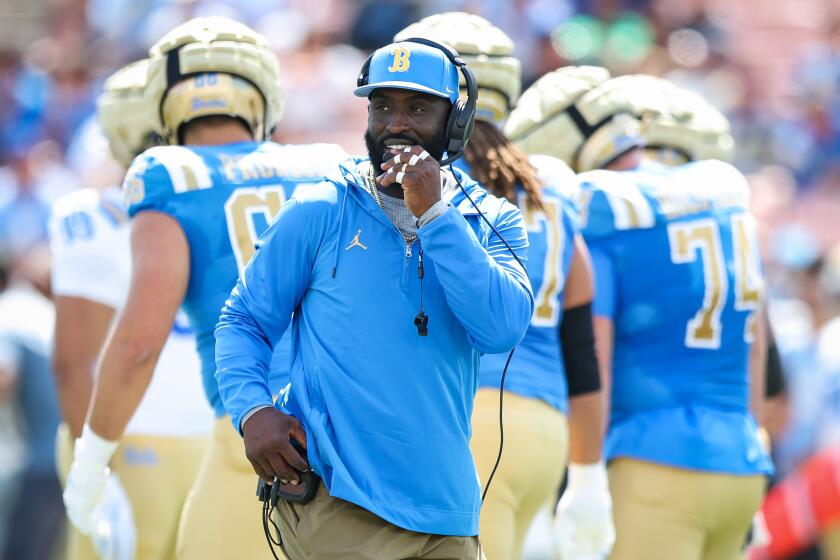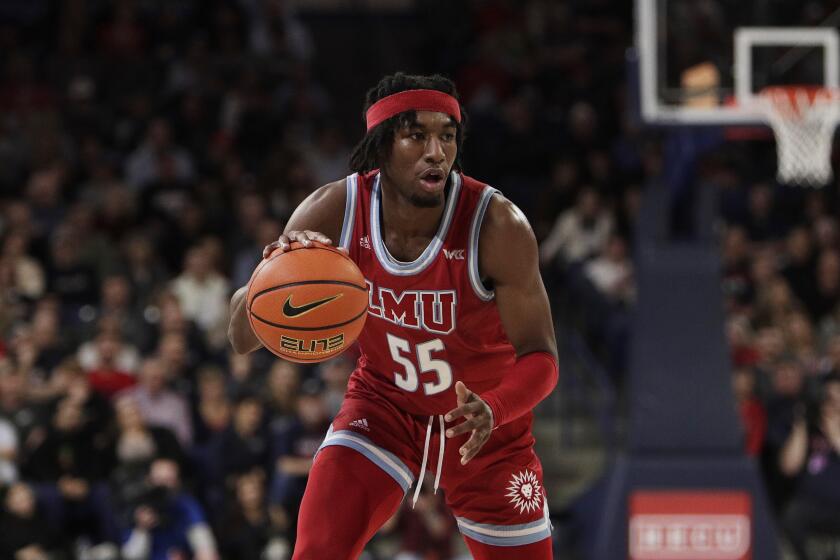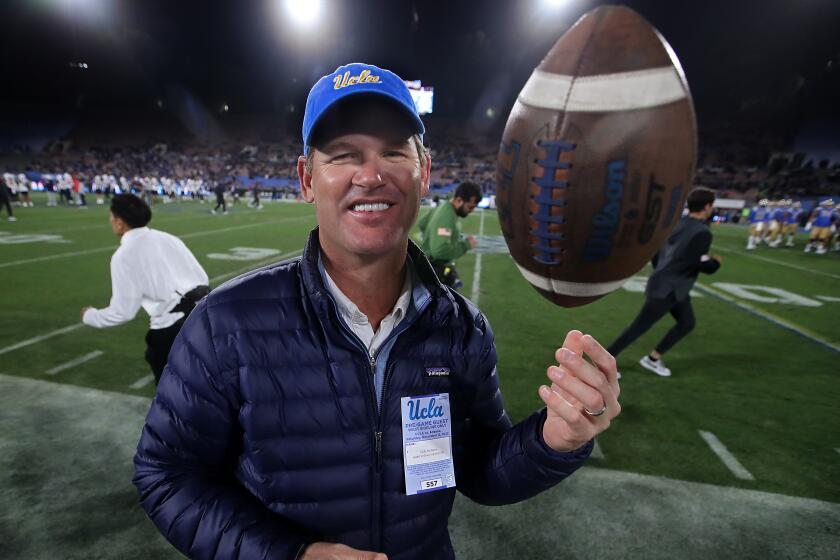UCLA’s challenge on defense against Houston on Saturday: Trying to keep lightning in a bottle
Negative thoughts do not come naturally to Rahim Moore, but this week a certain doomsday scenario has snuck into his head.
The UCLA safety knows the Bruins’ defense is a little inexperienced, especially up front. He knows that he and his teammates have been kept on the field a few too many minutes by a sputtering offense.
Now 23rd-ranked Houston comes to the Rose Bowl on Saturday night with an attack that moves the ball at breakneck pace, leading the nation with an average of 61 points a game.
A mistake here, a botched assignment there, things could turn ugly.
“You look up and it’ll be 72-0,” Moore said. “Literally.”
So the Bruins’ chances of rebounding from an 0-2 start in this nonconference game might rely on the defense keeping things close until quarterback Kevin Prince and the offense can find a rhythm.
“I don’t know that you can stop them,” Coach Rick Neuheisel said of the Cougars. “But you’ve got to try to slow them down.”
It helps UCLA’s cause that Houston quarterback Case Keenum has been day-to-day — his condition closely guarded — because of concussion symptoms lingering from last week’s 54-24 victory over Texas El Paso.
The fifth-ranked passer in the nation, Keenum has been medically cleared to play but still reportedly might not step onto the field.
It might not matter, given Houston’s impressive showing against Texas El Paso, replacement Cotton Turner completing nine of 10 passes and running back Bryce Beall accounting for 195 yards and three touchdowns.
None of that bodes well for a UCLA defense that ranks 116th in the nation against the run, allowing 262.0 yards per game, and surrendering an average of 369 total yards in two games.
“They’re still trying to find their way,” Houston Coach Kevin Sumlin said of the Bruins. “You hope they don’t find it by Saturday night.”
Of particular concern to UCLA — coming off a 35-0 loss to Stanford, its worst home defeat in more than two decades — is a defensive line that has four new starters and is still learning to trust their keys, and to react rather than think.
“It’s no different from me telling you, whenever I raise my right hand, I’m going to hit you upside the head,” defensive line coach Todd Howard said. “If I raise my right hand and you hesitate to duck, that means you’re not believing what I told you.”
With Houston’s quickness, the Bruins could get hit upside the head a few times.
“They’ve got a very athletic offensive line,” defensive tackle David Carter said.
The UCLA linebackers and secondary — anchored by Moore, strong safety Tony Dye and outside linebacker Akeem Ayers — have a bit more experience, but, still, coaches have needed to limit the playbook.
“You’ve just got to make sure they know what you’re calling,” defensive coordinator Chuck Bullough said. “If it’s too much, you’ve got to learn to scale back.”
The Bruins have also substituted more frequently to get the matchups they want against different offensive looks because the new guys simply aren’t as versatile as last season’s veteran crew.
The revolving door has spun ever quicker with UCLA ranking ninth among Pacific 10 Conference teams in time of possession, opponents holding the ball about 13 minutes more per game.
“It’s always a number count,” Bullough said. “As the plays get more, you’ve got to put more guys in.”
Frequent substitutions led to wasted timeouts against Stanford last week as players shuffled in and out. Granted, officials failed to give the Bruins proper time between snaps — a matter addressed by the conference this week — but that doesn’t change the fact UCLA needs to reach farther down the bench to keep fresh bodies on the field.
Underclassmen such as Keenan Graham and Cassius Marsh practiced with the starting defensive line this week, but will have to get up to speed immediately.
The Houston offense likes to deliver the ball quickly to playmakers in open space, giving them a chance to elude tacklers and turn a short pass into a bigger gain. Those types of plays have added up to 576 yards per game this fall.
“They spread us out and got angles on us,” UTEP Coach Mike Price said. “We only had one linebacker in the box, and they walled him off to make him miss tackles.”
While the new UCLA players try to acclimate, the veterans will adjust. For Moore, who led the team with 10 interceptions in 2009, that means less ball hawking — he has to play his position while watching for breakdowns elsewhere.
“Some situations I have to come out of what I do to go make a play on the other side of the field,” he said. “That’s just having experience and knowing what’s going on, know the strengths and weaknesses of our defense.”
The junior does not mind helping out. For now, he just wants to hold things together and give his less-experienced teammates a chance to catch up.
“Other teams are out-executing us,” he said. “If that happens, we’ll lose every game.”
david.wharton@latimes.com
twitter.com/LATimesWharton
Go beyond the scoreboard
Get the latest on L.A.'s teams in the daily Sports Report newsletter.
You may occasionally receive promotional content from the Los Angeles Times.




